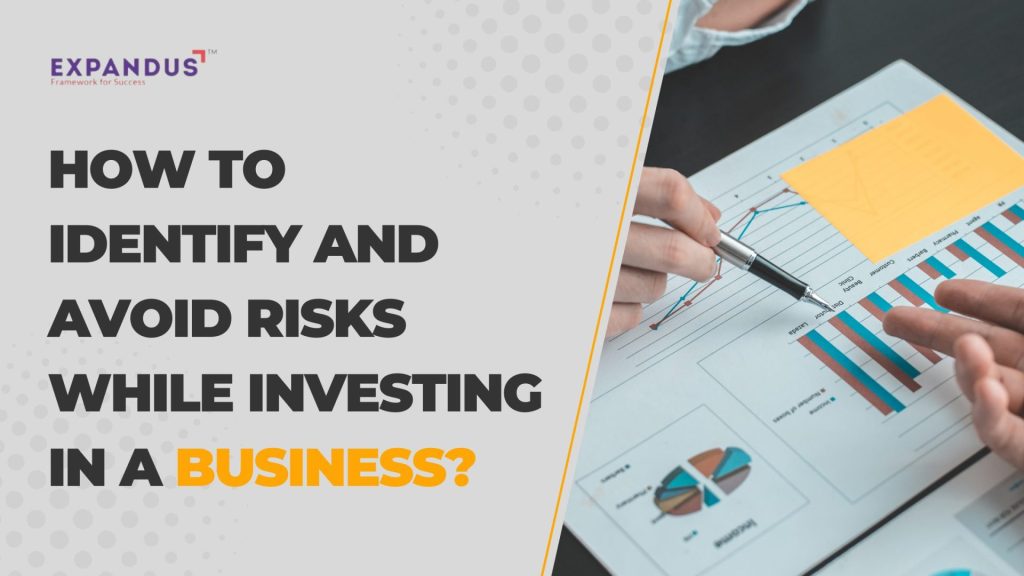How to Identify and Avoid Risks while Investing in a Business?
Investing in a business can be an exciting opportunity for financial growth, but it also comes with inherent risks. Understanding how to identify and avoid these risks is crucial for safeguarding your investments and maximizing returns. In this guide, we’ll explore key strategies and techniques to help you navigate the complexities of investing in a business while minimizing potential pitfalls. Whether you’re a seasoned investor or just starting out, mastering the art of risk identification and avoidance is essential for achieving long-term success in the world of business investments. Join us as we delve into practical tips and insights to identify and avoid risks in your investment journey.
Understanding Different Types of Investment Risks
Investing is a great way to build wealth, but it comes with different risks that can affect your money. Knowing about these risks helps you make better decisions and take care of your investments. Here, we’ll talk about four main types of investment risks: market risks, operational risks, credit risks, and legal and regulatory risks.
Market Risks
Market risk means the chance of losing money because of changes that affect the entire market. This risk is always there and can’t be avoided by diversifying your investments. Major sources of market risk include:
- Economic Factors: Changes in things like GDP growth, unemployment rates, and inflation can impact the market. For example, high inflation can lead to higher interest rates, which can lower stock and bond prices.
- Political Events: Elections, new laws, and international tensions can cause uncertainty and market volatility. For example, trade wars or government policy changes can greatly affect markets.
- Natural Disasters and Pandemics: Events like earthquakes or pandemics can disrupt markets. The COVID-19 pandemic, for instance, caused big changes in the global market.
Operational Risks
Operational risk comes from problems within a company’s own processes, systems, or people that can hurt investment returns. These problems can include:
- System Failures: Technology issues like software bugs or cybersecurity breaches can disrupt operations and hurt financial performance.
- Human Error: Mistakes made by employees, such as errors in data entry or poor management, can lead to financial losses.
- Fraud and Misconduct: Fraud or unethical behavior by employees can damage a company’s reputation and financial health.
Credit Risks
Credit risk, or default risk, is the chance that a borrower won’t be able to pay back their debt, leading to a loss for the lender or investor. This risk is important for investments like bonds. Key factors include:
- Borrower’s Financial Health: The borrower’s ability to pay back the loan, which is often shown by credit ratings. Lower credit ratings mean higher risk.
- Economic Conditions: During economic downturns, borrowers may find it harder to make payments, increasing the risk of default.
- Interest Rate Changes: Higher interest rates can make borrowing more expensive, leading to more defaults.
Legal and Regulatory Risks
Legal and regulatory risk is the potential for financial loss due to changes in laws or regulations that affect investments. Important considerations include:
- Regulatory Changes: New or changing regulations can impact how profitable and efficient businesses are. For example, stricter environmental rules can increase costs for manufacturing companies.
- Legal Disputes: Lawsuits against a company can result in financial penalties and hurt its reputation, which can lower stock prices.
- Compliance Requirements: Not following regulations can lead to fines and increased scrutiny from authorities.
Understanding these different types of investment risks helps investors create strategies to manage them, like diversifying their portfolio, doing thorough research, and staying updated on market and regulatory changes. By being aware of and handling these risks, investors can better protect their investments and reach their financial goals.
How to Identify and Avoid Risks Risks in Business Investments?
Identifying risks in business investments is super important for making good decisions. Let’s break it down into three easy steps: financial analysis, competitive analysis, and assessing management quality.
Financial Analysis/ investment analysis
Investment analysis helps you understand how healthy a business is financially. Here’s how you can do it:
- Look at Financial Statements: Check out the balance sheet, income statement, and cash flow statement. These papers tell you how much money the business has, how much it earns, and how much it spends.
- Check Profit Margins: Profit margins show how much money a company makes after paying its bills. Higher profit margins mean the company is doing well financially.
- Review Debt Levels: See how much debt the business has. Too much debt can be bad because it means the company has to pay a lot of money regularly.
- Analyze Cash Flow: Positive cash flow is when a company has more money coming in than going out. This is important for keeping the business running smoothly.
Competitive Analysis
Competitive analysis helps you understand how a business fits into its market and compares to other companies. Here’s what you can do:
- Identify Competitors: Know who the main competitors are. This helps you understand the market better.
- Compare Products and Services: Check out how the company’s products or services stack up against those of its competitors. Are they better, worse, or about the same?
- Check Market Position: Figure out how much of the market the company has. Having a big share of the market is good, but having a small one can be risky.
- Watch Industry Trends: Keep an eye on what’s happening in the industry. Changes in the industry can affect how well the company does in the future.
Assess Management Quality
The quality of the people running the company is super important for its success. Here’s how you can check it out:
- Experience and Track Record: Look at the management team’s past experience. Have they run other companies successfully before?
- Leadership Style: Good leaders can inspire and make smart decisions. Bad leaders can cause problems.
- Vision and Strategy: A clear plan for the future is important. The management team should have a solid plan to reach its goals.
- Reputation: Check out what people think about the management team. Good reputations mean they’re likely trustworthy and capable.
By checking out these things, you can find out if there are any risks in investing in a business and make better decisions. Easy peasy!
Tools and Techniques for Risk Assessment
Understanding and dealing with risks is super important, especially when making big decisions in business and investing. Let’s look at three easy ways of risk assessment: SWOT analysis, risk management software, and talking to experts.
SWOT Analysis (Strengths, Weaknesses, Opportunities, Threats)
SWOT analysis helps us look at both the good and not-so-good stuff about a business or investment. Here’s how it goes:
- Strengths: We figure out what the business or investment does really well, like having a great reputation or cool products.
- Weaknesses: We look at what could be better, like old technology or not enough money.
- Opportunities: We see what cool things could happen outside the business, like new trends or fancy gadgets.
- Threats: We think about what could mess things up, like competition or bad laws.
SWOT analysis gives us a good overall view, so we can make plans to use the good stuff and deal with the not-so-good stuff.
Investment Risk Management Software
Investment risk management software that helps us keep track of all the risks in a business or investment. Here’s what it does:
- Risk assessment strategies: It helps us find all the things that could go wrong.
- Sort Risks: It puts the risks in order, so we know which ones are the most important.
- Fix Risks: It helps us come up with ways to make the risks smaller.
- Keep Track: It helps us keep an eye on things, so we know if things are getting better or worse.
This software makes it easier for us to deal with risks, so we can keep our business or investment safe.
Talking to Experts
Sometimes, we need help from people who know a lot about risks. Here’s who we can talk to:
- Risk Management Consultants: These are people who are experts in risks. They can give us good advice based on what they know.
- Industry Specialists: These are people who know a lot about certain industries or areas. They can tell us about special risks that come with those industries.
- Legal and Regulatory Experts: These are people who know all about laws and rules. They can help us understand and follow the rules, so we don’t get in trouble.
So, by using tools like SWOT analysis, risk management software, and talking to experts, we can figure out what could go wrong and how to deal with it. Easy peasy!
Strategies to Reduce Investment Risks
Reducing investment risks is super important to keep your money safe and make sure your financial future is secure. Let’s check out some easy ways to do this:
Why Reducing Risks Matters
Reducing risks in your investments is a big deal because it helps you save money and make more of it. When you use smart strategies to cut down on risks, you can handle tough situations better, avoid big losses, and reach your money goals with less worry.
Contingency Planning
Contingency planning means getting ready for possible problems and having backup plans in case things go wrong. Here’s how it goes:
- Find Risks: First, think about what could go wrong with your investments, like the market suddenly dropping or unexpected events.
- Plan Ahead: Make backup plans for each risk you find. For example, if you’re worried about the market going down, think about spreading your money across different types of investments.
- Keep an Eye Out: Always keep track of how your investments are doing and be ready to change your plans if needed. This way, you can stay on top of things and avoid big losses.
Having backup plans ready helps you handle tough times and keep your investments safe, even when things don’t go as expected.
Insurance
Insurance is like a safety net for your investments. Here are some types to think about:
- Life Insurance: This helps take care of your family financially if something happens to you.
- Health Insurance: It covers medical costs, so you don’t have to worry about unexpected bills eating into your savings.
- Property Insurance: Protects your properties from things like fires or theft, giving you peace of mind.
- Investment Insurance: Some types of insurance can even protect your investments from losses due to market changes or other bad stuff.
By getting the right insurance, you can lower risks and keep your investments safe from unexpected problems.
So, by using strategies like contingency planning and insurance, you can make your investments safer and reach your money goals with less stress. Easy, right?
Wrapping It Up
In summary, when you’re investing in businesses, it’s super important to know about the risks and take steps to handle them. By doing things like checking everything carefully, spreading your investments, and planning for emergencies with things like backup plans and insurance, you can lower the chances of bad things happening to your money.
Also, keeping up with what’s happening in the market and any changes in rules is key for making smart decisions. Even though no investment is totally safe, if you learn about it and make careful choices, you can boost your chances of doing well. And remember, it’s not just about making money, but also keeping what you’ve earned safe. So, with the right attitude and plans in place, you can feel more confident about reaching your money goals.










